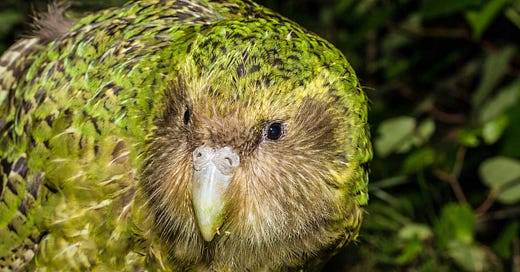Rare Kākāpō returning to the mainland to live
“Kākāpō are one of Aotearoa New Zealand’s most iconic and rare species, recovering from a population low of 51 birds in 1995. Until now, kākāpō have been contained to a few predator-free islands."
For the first time in nearly four decades, kākāpō will be living on mainland New Zealand.
The Department of Conservation in partnership with Ngāi Tahu is moving four male kākāpō from Whenua Hou/Codfish Island near Rakiura Stewart Island to Sanctuary Mountain Maungatautari, Waikato today.
DOC Operations Manager for Kākāpō Deidre Vercoe says returning the critically endangered nocturnal ground-dwelling parrot to the mainland is significant for all New Zealand, and a shared success story for all partners involved.
“Kākāpō are one of Aotearoa New Zealand’s most iconic and rare species, recovering from a population low of 51 birds in 1995. Until now, kākāpō have been contained to a few predator-free offshore islands, so to have them now returning to the mainland is a major achievement for all involved.”
The translocation comes after decades of hard work by DOC and Ngāi Tahu through the Kākāpō Recovery Programme, utilising both science and matauranga Māori to bring the species back from the brink of extinction. Since 2016 the population doubled to reach a high of 252 birds in 2022, and their island homes are almost at capacity.
Te Rūnanga o Ngāi Tahu Deputy Kaiwhakahaere Matapura Ellison says a key aspect of the translocation is the iwi ki te iwi (iwi to iwi) transfer of the four manu from Ngāi Tahu to Ngāti Koroki Kahukura, Raukawa, Ngāti Hauā, and Waikato.
“This is a milestone translocation, and we are thankful for our iwi partners who will keep our taonga (treasured) kākāpō safe at their new habitat on Maungatautari. The whanaungatanga between our iwi is strengthened further through the shared kaitiakitanga of these precious manu.”
The translocation marks a new phase for the recovery of this taonga species. A major goal for kākāpō conservation is to return them to their natural range on mainland Aotearoa in unmanaged populations, but they – like many other species – need habitat free of introduced mammalian predators.
Moving a group of the birds to the 3400ha approx. fenced sanctuary is an exciting next step for kākāpō recovery.
Sanctuary Mountain Maungatautari biodiversity team leader Dr Janelle Ward says kākāpō have been a feature of restoration plans since the ecological restoration project began.
“Decades of collaboration and partnership have led to this translocation. It is a great privilege to know we will be in the presence of critically endangered kākāpō and helping to support the next phase of kākāpō recovery.”
The translocation will be marked with a pōwhiri and celebration at Pōhara Marae followed by the release at Sanctuary Mountain Maungatautari. The formalities will acknowledge the many people and groups who have played a part in kākāpō conservation over the years, as well as the work put in by the Sanctuary to “kākāpō-proof” its predator-free inland sanctuary. It will also mark the transfer of care of the four founding birds between iwi.
Co-chair of the Ngāti Koroki Kahukura Trust Rahui Papa says Ngāti Koroki Kahukura acknowledge the honongā, or connection between Ngāi Tahu and the Waikato Tainui tribes.
“A Mana ki Mana agreement between the iwi groups sets out the expectation of kaitiaki responsibility, that comes with the acceptance of kākāpō on Maungatautari. This exchange reinforces previous understandings at the time of takahē translocation to the Waikato. It is a privilege to be entrusted with taonga from Te Waipounamu.”
As with any new phase in threatened species recovery, there is still an element of the unknown with this translocation, DOC’s Deidre Vercoe says.
“Sanctuary Mountain is a large space, with plenty of good habitat for kākāpō, but it’s still unknown whether they will successfully establish here long-term. The main focus of this translocation is to learn if kākāpō can thrive in a fenced sanctuary, while taking pressure off the islands ahead of future breeding seasons,” Deidre says.
The translocation fulfils one of the key objectives of the Kākāpō Expansion Project, funded by the International Visitor Levy.
The Kākāpō Recovery Programme has been supported since 2016 by national partner Meridian Energy, which provides funding as well as electrical infrastructure, technology and volunteering support to the programme.
Meridian Chief Executive Neal Barclay says Meridian is proud to be involved with DOC and Ngāi Tahu on the programme.
“Our combined efforts have been essential for saving this species from extinction and it’s pleasing to see the programme extend to include this new habitat at Sanctuary Mountain - Maungatautari. Together we have the power to make a difference.”
Deidre Vercoe says although the sanctuary is fenced, the kākāpō are still considered wild birds.
“Kākāpō are masters at camouflage, so it is very unlikely visitors to the sanctuary will come across them. However, the potential to hear their distinctive ‘booming’ calls across the Waikato landscape for the first time in generations is an important milestone,” Deidre says.
“It’s an exciting glimpse into what the future could be for our rare native birds, while serving as a reminder of why Predator Free 2050 is such an important goal.”
The kākāpō travelled with Air New Zealand, flying from Queenstown to Auckland. Air New Zealand is a national partner with DOC and has supported DOC to fly more than 4,200 threatened species and Conservation Dogs since 2012.





Amazing news 😍 congratulations to all those involved. Huge positive outcome for Aotearoa.
Before it became a sanctuary, I used to live on the edge of what is now the southern enclosure at Maungatautari. It's brilliant to hear their dream of having Kakapo is actually becoming true.